Crash prevention recorder (CPR)/video-flight data recorder (V-FDR)/cockpit-cabin voice recorder for light aircraft with an add-on option for large commercial jets
a technology of crash prevention and video flight data, which is applied in the field of aircraft avionics or flight electronics and also auxiliary airplane avionics support equipment, can solve the problems of high cost/megabyte, inflexible analog frame merging process, and inability to integrate data or telematics computer integration in the system with satellite navigation
- Summary
- Abstract
- Description
- Claims
- Application Information
AI Technical Summary
Problems solved by technology
Method used
Image
Examples
Embodiment Construction
[0602] FIG. 1. is a perspective drawing of the installed invention in the preferred embodiment in use with a single front engine, light airplane (9000). The three principle system components of the Electronic Rear View Mirror Component (100) (see Background Cross-Reference to My Related Inventions), the Video Recording Cameras Component (2000), and the Crash Prevention Recorder Package Component (4000) are shown.
[0603] FIG. 2 is a close-up drawing of the action of a pilot of the single front engine, light airplane (9000), looking into the Electronic Rear View Mirror Component (100) (see Background--Cross-Reference to My Related Inventions). The placement of the Video Recording Camera Components (2000), the Front Video Camera (2004), Rear Video Camera (2008), Left Video Camera (2012), and Right Video Camera (2016) are shown with the pilot video display.
[0604] FIG. 3 is a close-up view of the Electronic Rear View Mirror Component (100).
[0605] FIG. 4 is a close-up drawing of the action...
PUM
 Login to View More
Login to View More Abstract
Description
Claims
Application Information
 Login to View More
Login to View More - R&D
- Intellectual Property
- Life Sciences
- Materials
- Tech Scout
- Unparalleled Data Quality
- Higher Quality Content
- 60% Fewer Hallucinations
Browse by: Latest US Patents, China's latest patents, Technical Efficacy Thesaurus, Application Domain, Technology Topic, Popular Technical Reports.
© 2025 PatSnap. All rights reserved.Legal|Privacy policy|Modern Slavery Act Transparency Statement|Sitemap|About US| Contact US: help@patsnap.com



